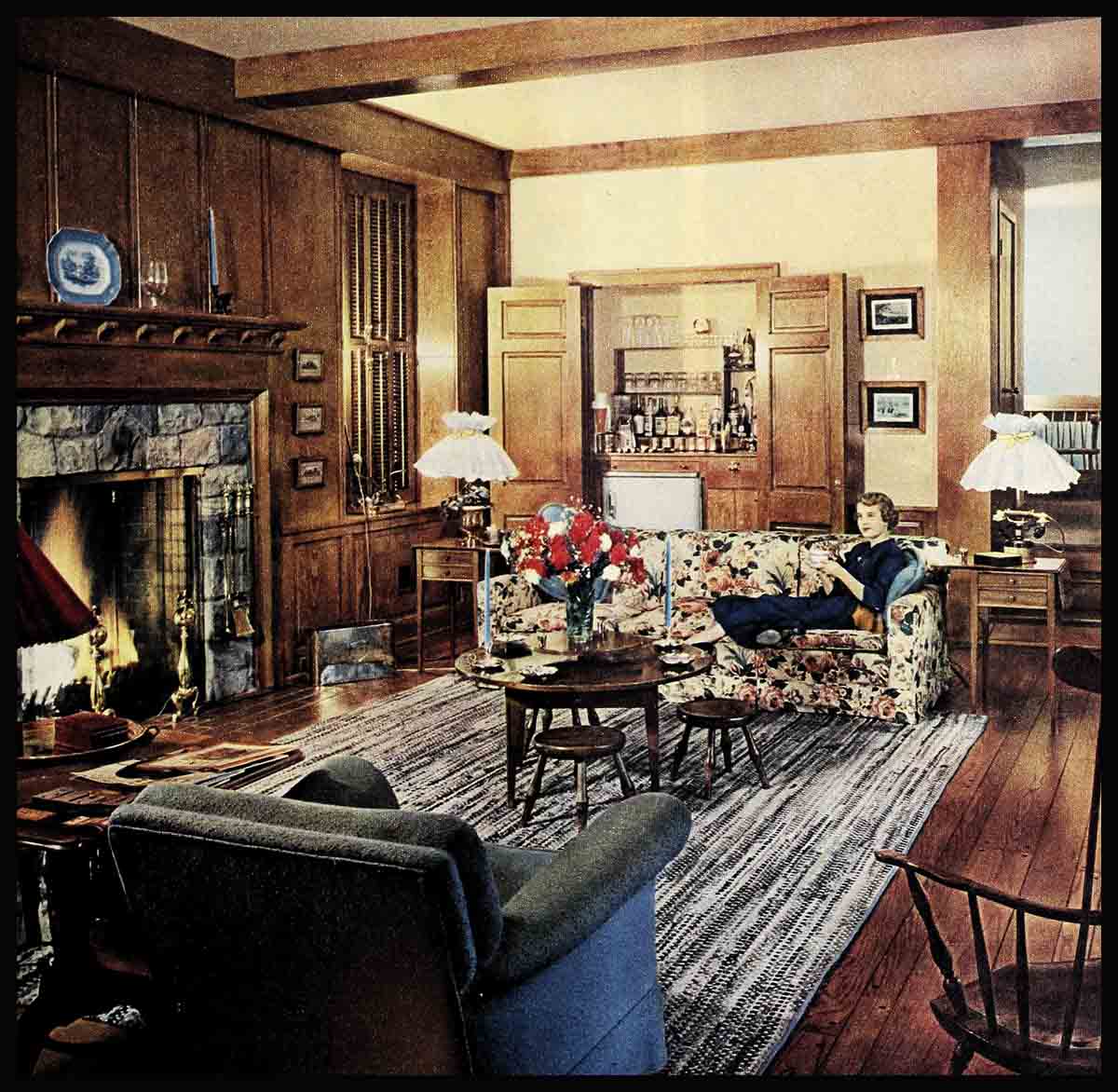
Halfway House—Mona Freeman
Comes September Mona Freeman and her husband, Pat Nerney, will celebrate their first year in their first home. Pat will surprise Mona with a check for a dining room. She hopes. For a year now they have been giving each other very practical presents like Venetian blinds, a dishwasher, a garage, and a landscape job on the front lawn. The landscape job, an expensive gift in California, was Pat’s present to Mona on Mother’s Day. Though she could easily pass for a teen-ager, Mona is twenty-four, has been married four years, and is the mother of a beautiful two-and-a-half-year-old daughter named Mona, and called Little Mona, or Monie.
Mona and Pat are typical of young Hollywood couples—and there are quite a few of them—who want a home of their own, but who do not want to go up to their eyebrows in debt to get it. “All young married couples,” says Mona “should have their own home. Pat and I couldn’t get ours at first, not knowing what to use for money.” Although Mona is one of the younger stars at Paramount, and Pat is a young salesman-executive in his father’s Ford Agency in Hollywood, neither is pulling in heavy dough exactly. And with taxes—oh well, you know all about taxes.
But with a little careful plotting and planning on their part they solved the problem of how to have their cake and eat it too. They built a small house that they could afford, or almost could afford, and they built it so they could add to it later without spoiling the design. “Besides the dining room,” says Mona, “there’ll have to be extra bedrooms. We plan to have at least two more children. Next time we’ll hope for a boy. Pat says there has to be another Ford dealer coming up soon.”

Theirs is the pay-as-you-go plan. The first practical step towards building a home, they decided after a year of marriage and apartment-living, was buying a lot. After much shopping around in Los Angeles suburbs they bought a lot in the Riviera section, formerly a big lemon grove, near Pacific Palisades. They kissed $7,500 goodbye sadly, but assured each other they had done the right thing. Now, they said, we’ll just dream about the house for the next five years.
With the arrival of Little Mona and her nurse, the small apartment with the paper-thin walls became a problem. One day when Mona was in the dumps because the baby didn’t have a back yard to play in like other babies, Pat said, “to heck with waiting.” He grabbed the phone and called Paul Williams, famous architect. He had designed Pat’s father’s home in 1936. Mona and Pat explained their financial situation (not good) to him, and he drew them basic plans for a Connecticut farmhouse, with a fieldstone front and a shake roof, that could easily be added to later. Pat, a genial soul, insisted only that the bath leading off the master bedroom have two washbasins. Mona was more piggish. She wanted a sunken living room with a pegged hardwood floor and a huge bay window. Huge bay windows, she discovered to her horror, cost like the dickens. So she settled for the sunken living room and the pegged hardwood floor. (In the early fall the big glass window on the patio side of the living room goes out, and the huge bay window comes in.)
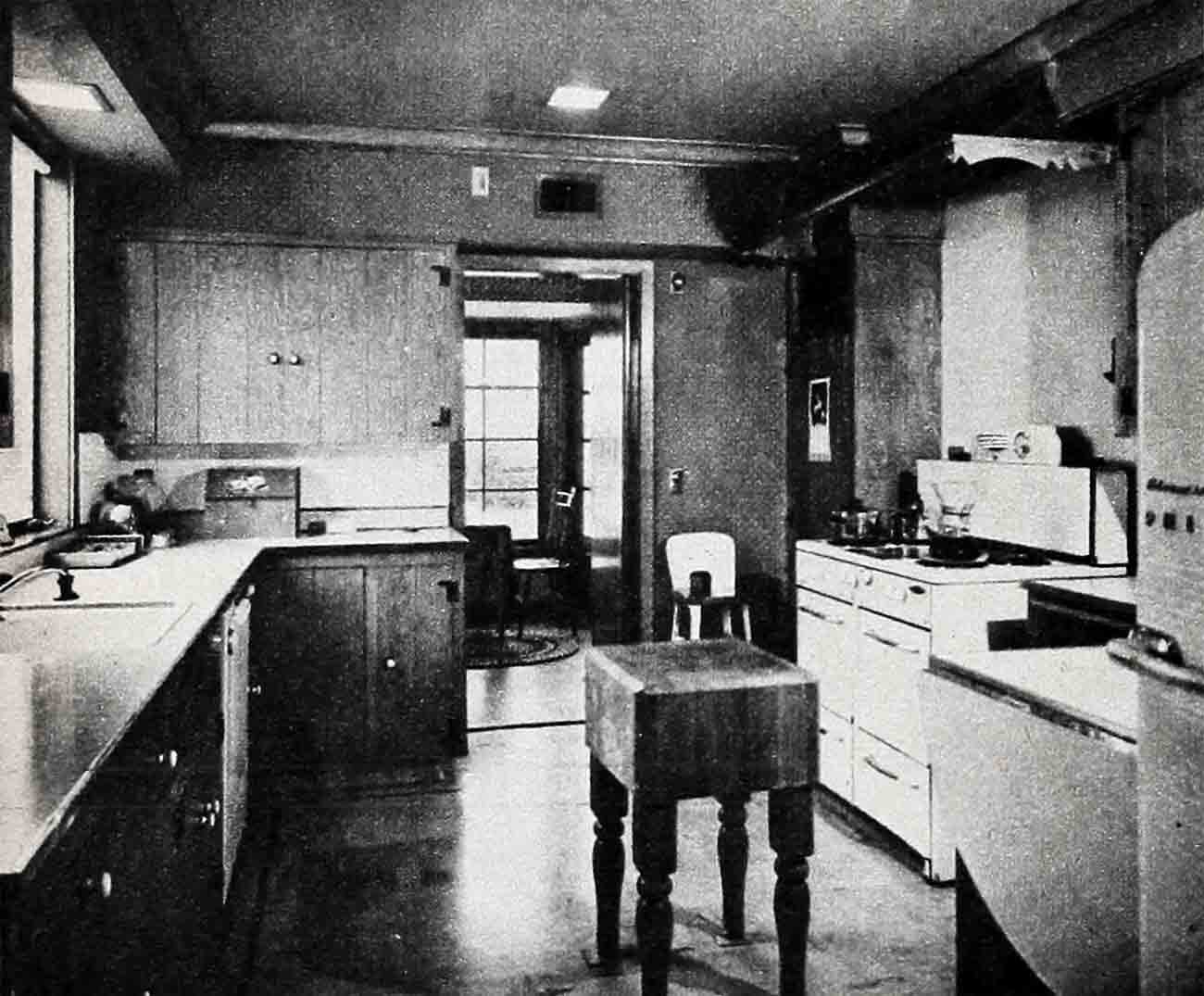
During the nine months that Mona and Pat have lived in their new home they haven’t spent a dime on furniture. Some of the furniture she brought from the apartment is very good, and some, she hastily adds, is very bad. Eventually she will weed out the bad stuff. Early American is her period.
A cherry-wood Lazy Susan, with several milking stools around it, takes center stage in the Nerney living room. On it Mona keeps flowers, blue candles in silver candlesticks, ashtrays and cigarette boxes. The rag rug of pastel colors, bought for the apartment, is much too small for the living room. But Mona doesn’t worry about it. The less you see of the rug the more you see of her precious pegged hardwood floors.
The piéce de résistance in furniture in this room is a Windsor comb-back chair. A real antique, not a reproduction. It stands next to the drop-leaf table that Grandfather Nerney gave them, and an old kerosene lamp which Mona painted in shades of blue. When Mona was pregnant she went slightly nuts over, no, not food, but furniture. At one antique shop she discovered this beautiful old chair and fell in love with it. “The price was awful,” says Mona. “I knew I couldn’t have the chair and a baby too. But I’d drive over every few days and just sit in that chair.”
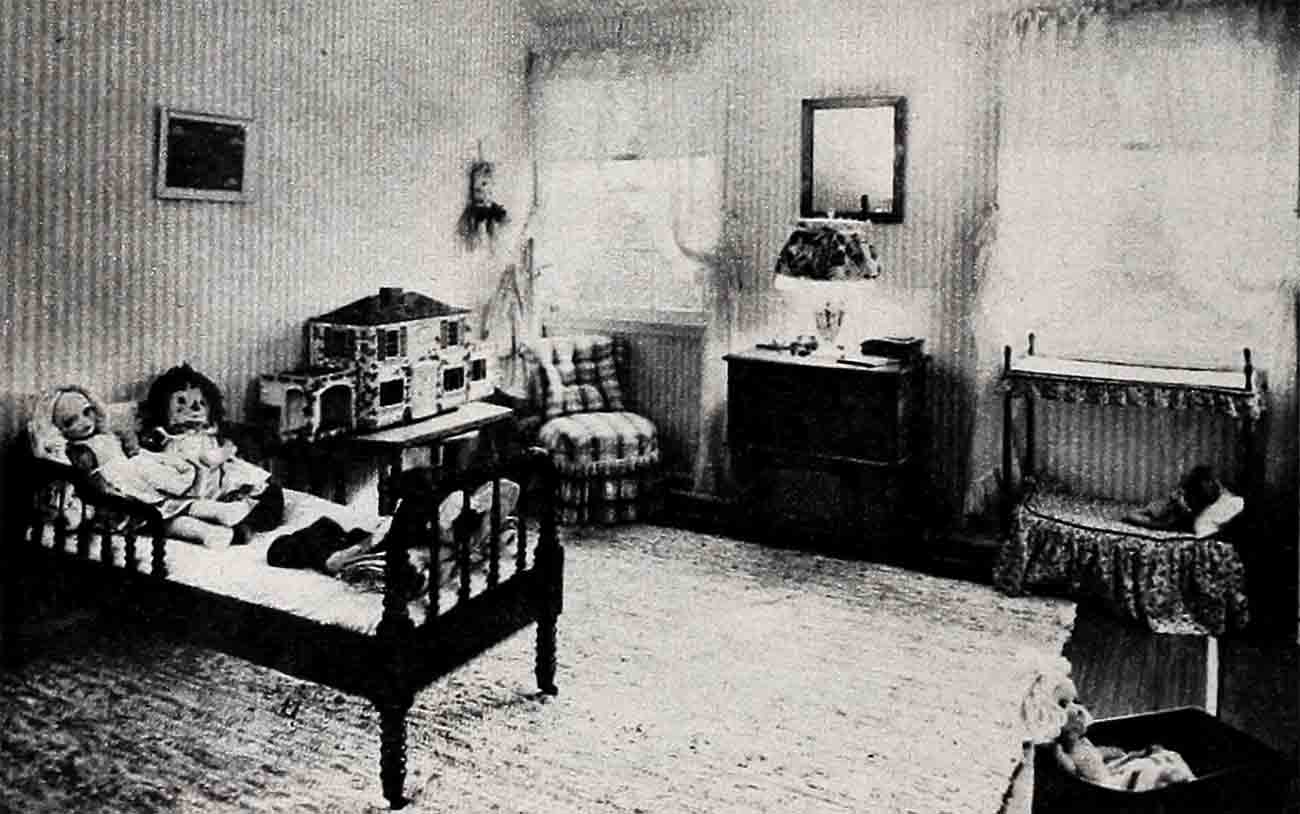
Well, of course, Pat got wind of all this. And when Mona came home from the hospital after the baby was born there was the chair with a pink bow around it. Pat told Mona he got a bargain in the chair. Mona’s not too sure about that. But he did get an old French telephone for free. Though not as avid about antiques as his bride, Pat did sort of take up with a very old French phone when he bought the chair. The shopkeeper gave it to him as a present. Later they had it made into a lamp with a shade of white cotton eyelet embroidery. Corresponding to this lamp is another lamp on the other side of the couch. It’s made of a brass vase filled with philodendron.
The fourth lamp in the room, on a table between two overstuffed chairs, is made of a champagne bottle, with a bright red pleated cover. The night Mona and Pat decided to get married they drove out to the Nerney Srs. to tell them the big news (Mona’s parents live in the East). Pat’s father said, “This calls for a special celebration,” and he dragged out a fine old bottle of wine he had been saving for an Occasion. The young Nerneys had the bottle made into a lamp.
Back of the couch, which is upholstered in a floral print, roses on a cream background, is the built-in bar. Except when the Nerneys are entertaining this is closed off by pine panelled doors. Next to it are spots reserved for a projection machine, and television. The couch has a broken spring, which is the thorn in the flesh, literally, of the Nerneys’ guests. But Mona sees no point in having the couch repaired when eventually she will be buying a new one. One overstuffed chair matches the couch, the other is covered in blue cotton. There are no drapes in the room. She is waiting for that “huge bay window” which will give the room “warmth.”

The large fireplace, made of fieldstone, takes up the greater part of one side of the room. The wall around it is panelled in pine. On one side of the fireplace is a window with shutters. On the other, a large bookcase. On the high mantel are two wrought iron candlesticks with blue candles, two brandy glasses, and a blue plate.
The handsome brass andirons were a housewarming present from Pat’s mother and father. Near the hearth is Mona’s baby chair. Mona’s mother brought it out on the train with her when she came out to meet her granddaughter.
There are four other interesting pieces in the Nerney living room from the antique and secondhand shops. An old cranberry picker which Mona uses as a magazine rack. A dry sink which was once lined with lead and used to hold buckets of water. Mona keeps some of her blue china on it, and a picture in a silver frame of herself and Pat taken the day they were married. A ladder-back Windsor chair “not very good,” and a desk which she picked up in a secondhand shop. She paid $65 for the latter. Her father, visiting Los Angeles at the time, scraped off the layers of paint on it, and found it to be beautiful mahogany. It took, him about three months to refinish it. He also did a scraping and refinishing job on the long Windsor carriage bench which Mona has in her front hall. Over the dry sink hangs an unusual painting—the outline for a piece of tapestry.
“It’s a rather expensive antique,” say Mona, “and the first thing Pat bought for the apartment after we were married. For a long time the only things we had in our apartment was that painting, a mattress and a box spring.”
Glass doors open from the living room onto the patio. The patio furniture is covered in yellow and coral, and was a “coming-home” present to Mona when she returned from the “Branded” location. Pat doesn’t mind any part about picture-making except locations. Mona has had to turn down several important picture parts because of long locations. “I can get another picture, but I can’t get another husband,” she says.
As the Nerneys have no dining room as yet they eat dinner at night on trays in the living room—or else in the breakfast room. The dining room will be built off the breakfast room, which will then become a pantry. Mona has definite ideas about the dining room. It will be a combination dining room, den and playroom. And it undoubtedly will have huge bay windows.
Except for the gray carpeting, Mona has done nothing so far with the master bedroom and her dressing room. She has two Victorian chairs, covered in American Beauty red velvet. And a temporary bed.
The baby’s room, however, is complete. And a joy to behold. All the Nerney children and grandchildren have slept in the same youth spool bed. Monie is the present occupant. Although she has been trained to keep her toys in an antique trunk, she manages to scatter her dolls, of which she has a goodly number, all over the room. She has a large dollhouse on a table near the bed, and in the corner a four-poster-canopy doll bed which Mona’s father made. There’s a slipper chair covered in plaid gingham, and an old pine commode for her clothes. The walls are papered in pink-and-white striped wallpaper. The curtains are dotted Swiss trimmed in eyelet ruffles. The floor is covered with blue linoleum, and over it is a rag rug in soft pastel shades. In one corner are two little wooden chairs and a low table. Over Monie’s bed is a painting of a duck. It’s an original Pat Nerney, the beginning of his artistic efforts. Before she goes to bed Monie always has to kiss the duck goodnight.
Instead of the conventional white cabinets in the kitchen Mona preferred natural wood with old-fashioned white glass knobs. The dish-washer, stove and refrigerator are the only white enameled pieces in the kitchen. The walls are covered with an attractive wallpaper having an old rose background with tiny blue flowers. There is a copper hood over the stove to give it the Early American flavor. The floor is covered in natural blocked linoleum outlined in rose. Mona’s chief delight in the kitchen is a meat block which she found in a secondhand store, and which makes a most unusual kitchen table.
In my peregrinations around Hollywood I have found some awfully sloppy garages. They seem to be catch-alls for just about any old thing from empty beer bottles to blue jeans and cast-off mattresses. Mona’s garage opens on the court in front of the house. It’s spick-and-span. It is papered in yellow wallpaper featuring old-time trains and steamboats. The back of the garage is lined with cabinets instead of open shelves. Here she can store the usual eyesores.
What kind of a car is in the garage? Why a Ford, but, of course.
THE END
—BY LYLE WHEELE
It is a quote. PHOTOPLAY MAGAZINE SEPTEMBER 1950



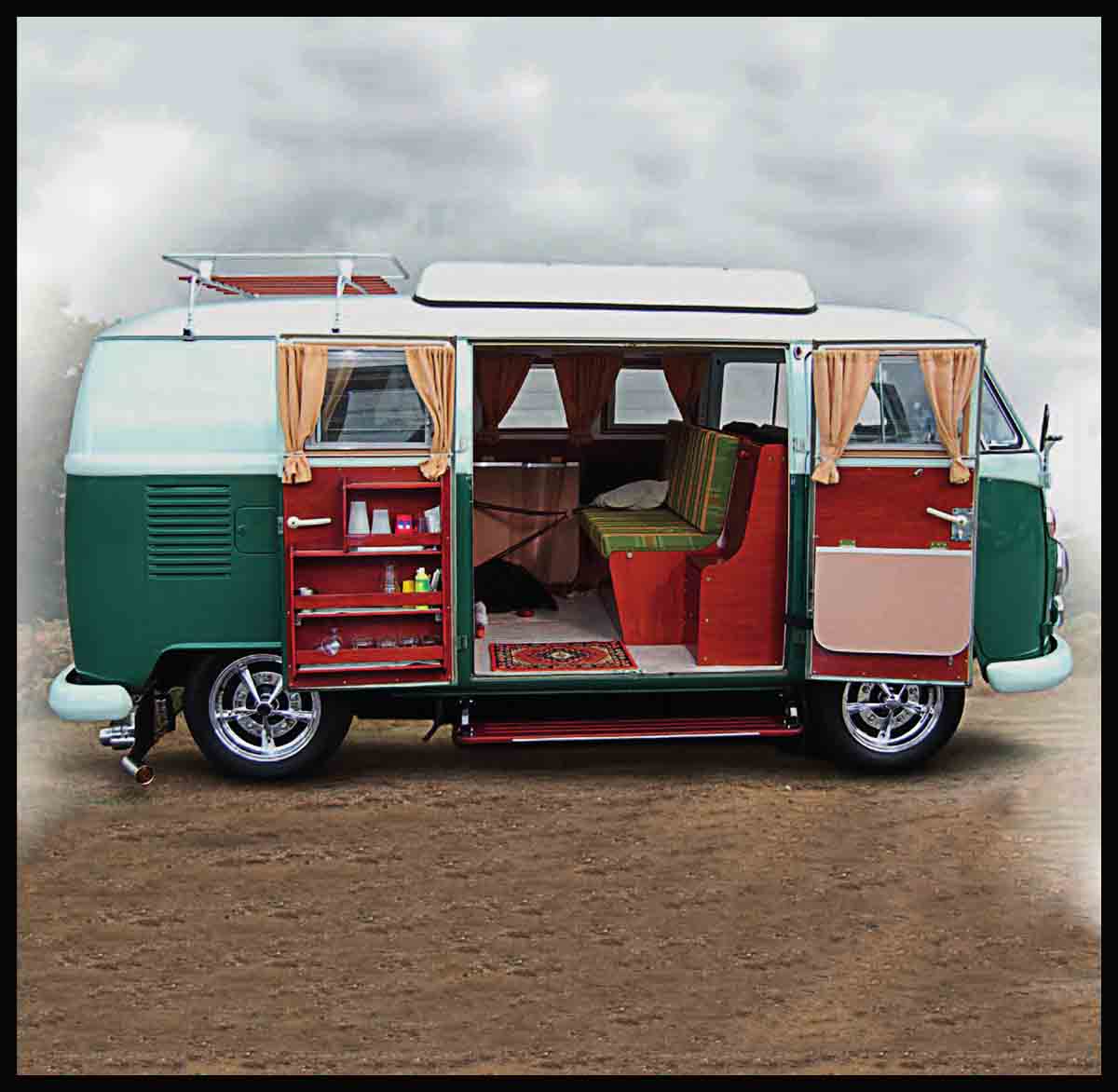
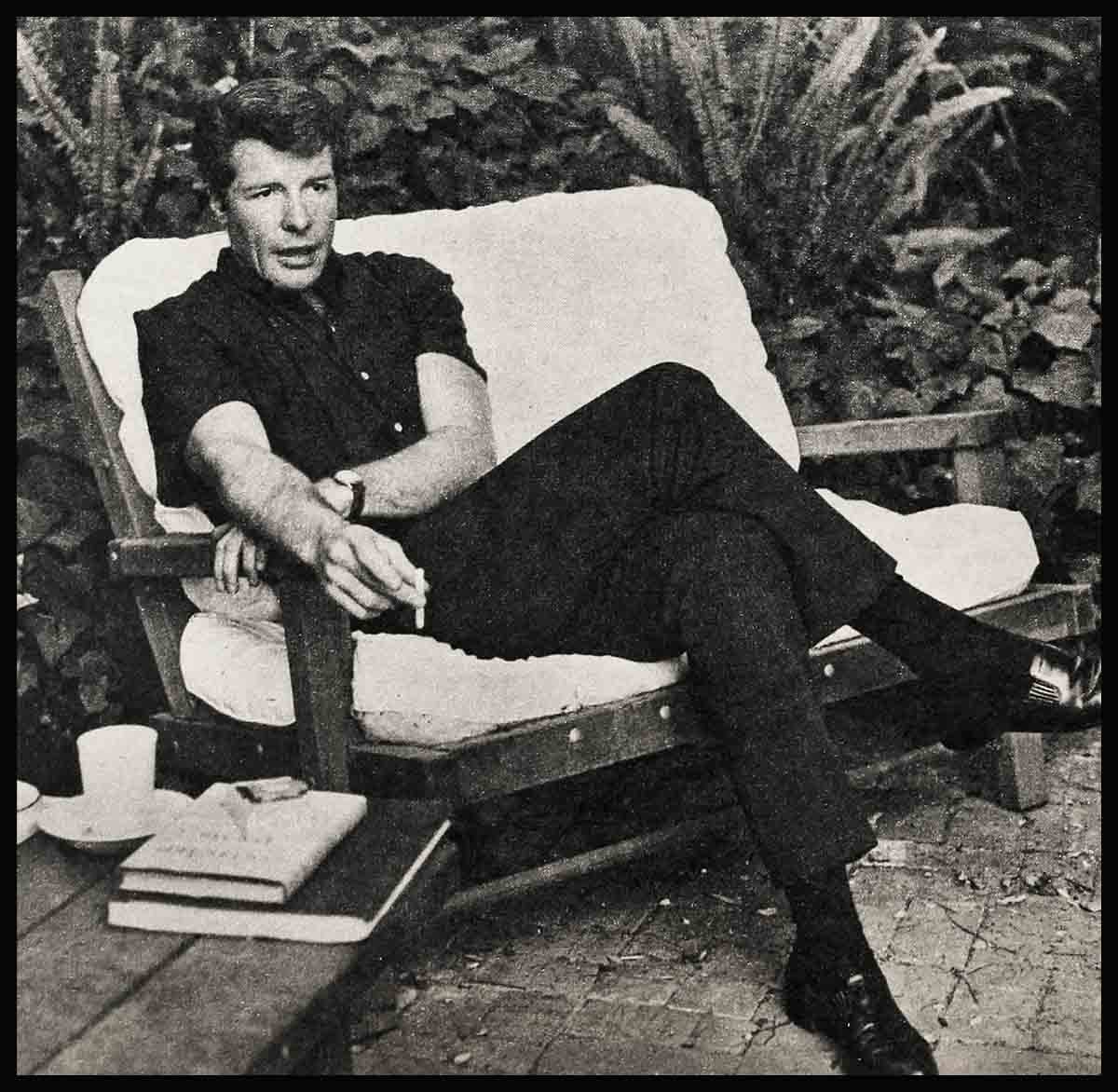
vorbelutr ioperbir
4 Temmuz 2023You really make it appear really easy along with your presentation however I find this topic to be really one thing that I think I might never understand. It kind of feels too complicated and extremely large for me. I’m looking ahead on your subsequent publish, I’ll try to get the dangle of it!